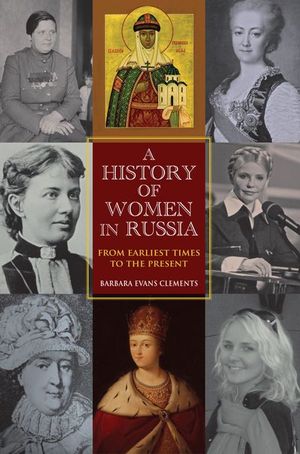A History of Women in Russia
Published by Indiana University Press
A survey of the key political, economic, social, and cultural developments in Russian women’s history from 900 to 2010, and their impact on the nation.
Synthesizing several decades of scholarship by historians East and West, Barbara Evans Clements traces the major developments in the history of women in Russia and their impact on the history of the nation. Sketching lived experiences across the centuries, she demonstrates the key roles that women played in shaping Russia’s political, economic, social, and cultural development for over a millennium. The story Clements tells is one of hardship and endurance, but also one of achievement by women who, for example, promoted the conversion to Christianity, governed estates, created great art, rebelled against the government, established charities, built the tanks that rolled into Berlin in 1945, and flew the planes that strafed the retreating Wehrmacht. This daunting and complex history is presented in an engaging survey that integrates this scholarship into the field of Russian and post-Soviet history.
“The product of a lifetime of engagement by one of the preeminent authorities on the history of Russian women, the book reflects the author’s deep expertise in primary sources as well as her familiarity with the secondary literature.” —Choi Chatterjee, California State University Los Angeles
“A significant achievement in scholarship on Russian women and gender. . . . Among this text’s many strengths are its lucidity, readability, and engaging synthesis of a large number of both primary and secondary sources. . . . Its erudite contextualization of the history of Russian women within a larger European framework ensures its interest for and accessibility to a wide readership, especially those outside of the Slavic field.” —Slavic and East European Journal
“Clements’s writing is engaging, clear, and jargon free, making this book easily accessible to a general audience. . . . Highly recommended.” —Choice
“This daunting and complex history is presented in an engaging survey that integrates this scholarship into the field of Russian and post-Soviet history.” —Journal of Turkish Weekly
Synthesizing several decades of scholarship by historians East and West, Barbara Evans Clements traces the major developments in the history of women in Russia and their impact on the history of the nation. Sketching lived experiences across the centuries, she demonstrates the key roles that women played in shaping Russia’s political, economic, social, and cultural development for over a millennium. The story Clements tells is one of hardship and endurance, but also one of achievement by women who, for example, promoted the conversion to Christianity, governed estates, created great art, rebelled against the government, established charities, built the tanks that rolled into Berlin in 1945, and flew the planes that strafed the retreating Wehrmacht. This daunting and complex history is presented in an engaging survey that integrates this scholarship into the field of Russian and post-Soviet history.
“The product of a lifetime of engagement by one of the preeminent authorities on the history of Russian women, the book reflects the author’s deep expertise in primary sources as well as her familiarity with the secondary literature.” —Choi Chatterjee, California State University Los Angeles
“A significant achievement in scholarship on Russian women and gender. . . . Among this text’s many strengths are its lucidity, readability, and engaging synthesis of a large number of both primary and secondary sources. . . . Its erudite contextualization of the history of Russian women within a larger European framework ensures its interest for and accessibility to a wide readership, especially those outside of the Slavic field.” —Slavic and East European Journal
“Clements’s writing is engaging, clear, and jargon free, making this book easily accessible to a general audience. . . . Highly recommended.” —Choice
“This daunting and complex history is presented in an engaging survey that integrates this scholarship into the field of Russian and post-Soviet history.” —Journal of Turkish Weekly
BUY NOW FROM
COMMUNITY REVIEWS

